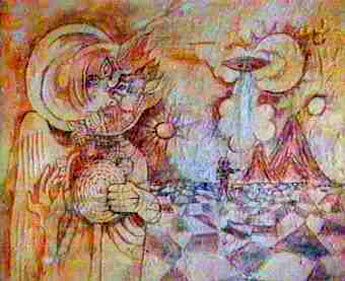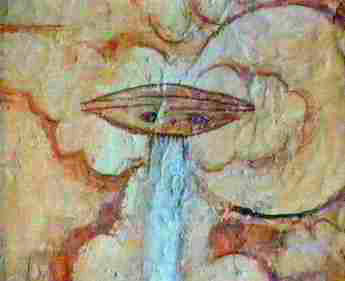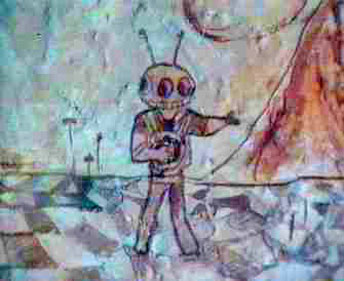|
Conocida como El Hombre de Marte, esta pintura fue descubierta
por el arqueólogo Guergui Chatski, en la región de las cuevas
de Fergana en Uzbekistán, junto a gran cantidad
de otras pinturas rupestres.
Correspondería al periodo Neolítico. El comienzo del
Neolítico varía según las regiones: en Oriente próximo tiene lugar
hacia el 7.000 A.C.; en el Mediterráneo oriental sobre el 4.000 AC.
y en Europa occidental alrededor del 3.000 A.C.
A SIMPLE VISTA se puede distinguir:
-
Sobre las Montañas: Un extraño objeto, que se encuentra
suspendido sobre una columna de humo.
-
En el Suelo: Un extraño ser, con un casco dotado de
antenas, extendiendo su mano derecha, mientras que la otra
permanece a la altura del vientre o cinturón.

 
|
GRABADOS
RUPESTRES DE FERGANA
Próximo de la
población de Fergana, cerca de los montes Alai, en el
Uzbekistán, existe esta pintura rupestre con 2 metros de altura
y diez mil años de antigüedad. La Academia de las Ciencias de
Moscú tiene expuesta una copia de esta imagen |
Es significativa también
la presencia en el cielo de tres cuerpos celestes, el Sol, la Luna y
otro que no se puede identificar, todos ellos situados sobre las
montañas.
En primer plano, a la izquierda de la imagen, otro extraño y curioso
ser, que sujeta con una mano enguantada (en el que se pueden
apreciar hasta las costuras) un disco, en el que se distinguen una
serie de surcos sobre su superficie.
Ancient Astronauts in Fergana?
from
Ufologie Website
The Ferghana horse is gamed among nomad breeds.
Lean in build, like the point of a lance;
Two ears sharp as bamboo spikes;
Four hoofs light as though born of the wind.
Heading away across the endless spaces,
Truely, you may entrust him with your life...
Tu Fu,
poëte Chinois, 8e siècle.
FERGANA CAVE PAINTINGS,
UZBEKISTAN
In an article of the of French ufology magazine "Lumières dans
la Nuit" ("Lights in the Night") issue 335 of February 2000,
Didier Leroux tried to find the source of this image,
successfully.
He found out that image was painted by a contemporary Russian
artist to illustrate the cover of a 1967 issue of the "Sputnik"
Russian magazine, in which there was an article devoted to the
topic of visits of ancient astronauts 12.000 years ago, which
had been inspired among other stuff by the prehistoric paintings
in the caves of Fergana in Uzbekistan in which certain
characteristics were considered as possibly some ancient close
encounter of the third kind.

These paintings seem to exist, but
they are sometimes dated back to 2000 BC, sometimes 7000 BC,
rather than 10.000 BC.
The cover illustration of the Sputnik magazine was cropped out
and included in Erich Von Daniken's book "Chariots of the Gods,"
and thus instead of the true cave paintings of Fergana, the
fictitious illustration spread as the real thing.
Sputnik magazine, published in Reader's Digest format, was
published in several languages in the Sixties and was one of the
rare publications where Russian scientists, as well as laymen
and fantasy-prone authors were allowed to pass some texts to the
West, amongst other things, texts related to the UFO phenomenon.
So the whole matter seems quite simple. But I also found the
cover of another magazine (on the Internet), SHOWN far below, which
still says that the drawing is the real thing, while clearly the
signature of an artist appears in the bottom on the right.
On
top on left, it is specified that the drawing illustrates an
article by Dr. Vyacheslav Zaitsev, Russian philologist, whose
name is related to the case of
the Dropas.
By examining the image, it seems obvious that it rather or also
relates to the Dropas: see the disc with the spiral carving held
by the cosmonaut and the high mountains.
As a matter of fact
Fergana is only at some hundreds miles of Baya-Kara-Ulan.

"click"
Below, the painting by a Russian artist supposed to be an
authentic cave painting in the caves of Fergana.
The image is
different and probably older than the drawing above and
obviously inspired it, and is quite probably the one presented
in
the Sputnik magazine of 1967.

Fergana is a valley in Uzbekistan, famous because the road to
the silk passed through it.
It
seems that there are really prehistoric caves there, showing
these "ancient astronauts" paintings which inspired the
Sputnik
Magazine article and illustration:
 
REFERENCES:
-
"Chariots of the Gods", Erich Von Daniken, Souvenir Press, 1973.
-
"Die große Erich von Däniken Enzyklopädie" book by Ulrich
Dopatka, Econ Verlag GmbH, Düsseldorf, 1997.
-
"Spaceships in Himalaya" article by Vyacheslav Zaitsev, Sputnik
magazine, 1967.
-
Article by Didier Leroux in "Lumières dans la Nuit" magazine,
#335, February 2000.
UFO RESOURCE CENTER
UFORCE CASE STUDY
The Chu Pu Tei Expeditions 1937-1938
from
UFORESOURCECENTER Website
recovered through
WayBackMachine Website

From FLYING SAUCERS;
Mysteries of the Space Age*
*
Von Daniken has suggested that the image of the creature pictured above was
taken from that cave drawing. UFORC has tracked down this rendering of an
ancient astronaut to a work entitled SPUTNIK. From there, the trail gets
cold. We saw it pictured in an issue of FLYING SAUCERS magazine published in
April of 1967 and we are still unable to verify its mysterious origins.
See also Das Vegetarische Universum, 1962(?), which had allegedly published
a paper by Professor Chu Pu Tei and four of his colleagues entitled "Groove
Writing Relating to Spaceships." Their paper was allegedly banned by the
Peking Academy of Pre-History, which later allowed publication of this
collective work.
Zaitsev had published two other books entitled Cosmic Reminiscences in
Written Relics of the Past and another work entitled The Evolution of the
Universe and Intelligent Beings.
CHU PU TEI Expedition, CHINA 1937
During an expedition into a remote, isolated region of Tibet in 1937, an
archeologist by the name of Chu Pu Tei made an amazing discovery.
700
discs were allegedly recovered from some caves that tunneled deep into the
mountainside. Also found were numerous graves, which contained the remains
of humanoid-like beings that were very short with disproportionately large
heads. On the walls of one cave was found some cave drawings, replete with
what appeared to be star maps and a sketch of what those beings might have
looked like.
This find was extraordinary, according to a researcher by the name of
Clark McClelland. While researching from his Pittsburgh library,
McClelland had uncovered a work done by Vyacheslav Zaitsev, which was
originally published in the
Russian magazine SPUTNIK in 1963. In his
work the 'Chinese Connection,' McClelland reveals that a race of
extraterrestrial beings may have interbred with the aboriginal inhabitants
of this mountainous area some 12,000 years ago.
The aboriginal inhabitants of that region are known as the Khams and
the Dropas
tribes. They are pygmy-like, with unusually large heads and are 'difficult
ethnically to classify.' McClelland notes that they are different than the
'Chinese, Tibetans and Mongols.'
According to local legend, a band of living things, which were very ugly,
landed their spacecraft here on earth. They frightened the local tribes
people so badly, that the extraterrestrials were hunted down. Many of their
kind were killed. These beings hid in caves to escape the slaughter. They
were later found in the Payank Ara Ula Mountains. The local
inhabitants tried to make amends by bringing gifts to the creatures. But
when the extraterrestrial came out of their caves to accept the peace
offerings, they were so extremely repugnant to the aboriginal inhabitants
that the slaughter began anew.
Ancient Chinese legend talks about a race of 'little yellow creatures' that
had come 'down from the stars.' They had 'big heads and small bodies.' This
sounds very much like the extraterrestrials that many UFO eyewitnesses claim
to see today.
The graves were arranged in neat, orderly rows. The average length of the
corpses that were exhumed was reportedly around 5 feet in length. Their
craniums were unusually large, certainly larger than one would expect from a
human of that size. This is significant, given the morphology of the local,
aboriginal tribes the Khams and Dropas.
The German Das Vegetarische Universe had published an article about
the discs in 1962. According to the journal, a professor at the Peking
Academy of Prehistoric Research had announced a startling discovery. Tsum
Um Nui had deciphered the grooved symbols on some of the discs.
According to Tsum, the discs document a story about the space beings. His
discovery would seem to substantiate the folk account rendered by that
aboriginal tribe's people, the Khams and the Dropas.
What is really fascinating is the composition of the discs, which Chu had
recovered on his expedition into the mountains of Tibet. According to
Leonard Stringfield, some of those discs were pirated away to Moscow for
further study. Several scientists were given the task of studying the discs
and then they were to elaborate on their composition. What they had
discovered is amazing, in that the technology represented by the discs would
equal or rival our own Compact Discs in use today.
Keep in mind that they were
allegedly manufactured around 12,000 years ago!
-
COMPOSITION:
Primary composition:
Discs were made of granite, a substance that would last thousands of
years, if care was given to protect them from harmful influences
(which they were). They contained a high content of cobalt and
aluminum.
-
SPECIAL
CHARACTERISTICS:
McClelland notes that
the discs had 'a highly resonant frequency,' which indicates that
they 'may all be carrying an electric charge.' The properties of the
material were such that 'since granite is largely composed of
silicates and cobalt in metal with properties of magnetism and
corrosion-free, these stone discs could practically last forever.'
-
DIMENSIONS:
The discs were all of
a uniform size. They measured 0.8 meters in diameter and 2.0
centimeters in thickness. The equivalent in US measure would be
31-1/2 inches in diameter and 7/8ths inches in thickness.
-
GROOVES:
Each of the 700 discs
had double grooved indentations which had tiny symbols engraved on
them. Compare to the material which was allegedly recovered from the
Roswell crash in Corona, 1947.
-
ELECTROMAGNETIC
PROPERTIES:
McClelland elaborates
on the possible use of those discs with data from the 'Chinese
Connection:'
-
"These embedded
alloys of silicon, cobalt and aluminum which are found as part
of the spiral grooves could very possibly form an electronic
recording capability similar to that used in present-day
magnetic recording machines. Perhaps these strange discs carry
two messages, one written in symbols on the grooves and perhaps
sounds or information recorded within the electrical charges. If
true, it could be in the language of its original creators-the
frail creatures with large heads in myth and legend."
-
McClelland
What was the ancient
astronaut trying to tell us in that drawing popularized by Vyacheslav
Zaitsev in SPUTNIK magazine?
We can only speculate.
But the similarities between
the Chinese-like glyphs that were recovered from the UFO crash-site in 1947
and those described by the Moscow scientists from the Tibetan Discs
recovered in 1938 are uncanny.
References:
(For further study)
1. Leonard Stringfield
UFO CRASH/RETRIEVALS: AMASSING THE EVIDENCE Status Report III; 1982
Leonard Stringfield; Cincinnati, Ohio by L.H. Stringfield.
2. Vyacheslav Zaitsev SPUTNIK The Russian Digest;" 'Visitors From Outer
Space: Science versus Fiction' 1963 (condensed from the almanac Na Sushe
i na more 'On Land and at Sea') by Vyacheslav Zaitsev.
3. FLYING SAUCERS: Mysteries of the Space Age; page 17; April 1969 Issue
number 63; Palmer Publications, Inc Amherst, WI
|










